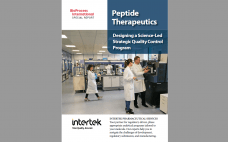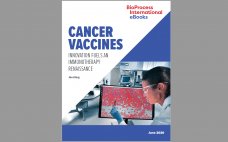Gastric delivery is unachievable for most biopharmaceuticals, so drug developers formulate biologics primarily for intravenous infusion or injection. However, inhaled and nasal delivery options are attracting considerable attention because they enable targeted delivery of a wide range of therapeutic proteins. On 23 June 2020, Mark Parry (technical director at Intertek) presented an âAsk the Expertâ webinar that described critical considerations for inhaled and nasal delivery for biologics. Parryâs Presentation Because biopharmaceuticals are complex products, developers need compelling reasons to choose…
Manufacturing
Ask the Expert: Ultrapure Gelatin Can Optimize Your Excipient Screening for Vaccine Formulation
In his 28 May 2020 âAsk the Expertâ presentation, Jeroen Geeraerts (business development manager at Rousselot) highlighted that, as of May 2020, 118 candidate vaccines for the novel coronavirus (SARS-CoV-2) had reached clinical or preclinical evaluation. Of those, 11 use inactivated and liveâattenuated approaches, which require strong stabilizing agents to maintain vaccine potency. Geeraerts explained why inactivated and liveâattenuated vaccines require stabilizing agents and why vaccine companies prefer pharmaceutical-grade gelatin for such applications. Next, Geeraerts described how his companyâs X-Pure…
Democratizing Access to Cancer-Related Proteomic Data
The US National Cancer Institute (NCI) has launched the Proteomic Data Commons (PDC), a next-generation proteomic data repository that will facilitate data access, sharing, and analysis to speed development of precision-medicine therapies for cancer. Housed within the NCIâs Cancer Research Data Commons (CRDC), PDC hosts several multiomic data sets that have corresponding genomics and imaging data elsewhere, simplifying their access to enable integrative research. Increase Access to Enable Discovery Mass spectrometry (MS)âbased proteomic profiling for pancancer analyses could enhance our…
Peptide Therapies: Designing a Science-Led Strategic Quality Control Program
Peptide therapeutics are a unique class of pharmaceuticals. They can fall into one or more regulatory categories: as conventional chemical molecules, biological entities, or biosimilars. Developing a wellâthought-out quality control (QC) strategy is key to meeting development milestones and complying with evolving regulatory requirements. Safety assessment is critical because slight changes in the structure, physicochemical properties, stability, and impurity profile of a peptide can provoke an adverse immune response. A robust analytical QC program should be conducted in laboratories that…
eBook: Challenges in Industrial Process Development of Exosome-Based Therapies: Characterizing and Managing Diversity
The traditional classification of extracellular vesicles (EVs) includes three types: exosomes, microvesicles, and apoptotic vesicles. Each type arises from a distinct origin and exhibits distinct characteristics. The problem is that their size ranges overlap and that the major surface proteins presented by exosomes also are present on the surfaces of microvesicles and apoptotic bodies. This makes it a challenge for process developers to identify the vesicle fraction that best serves a particular exosome therapy. Anion-exchange chromatography (AEC) can fractionate EVs…
Giving You the Power for Clinical and Commercial Success
As a result of increased focus on customized medicine and continued emphasis on drug development for rare diseases, the biopharmaceutical industry continues to advance its methods for disease treatment by developing target-specific novel therapeutics. Formulations for these types of programs are complex and therefore present challenges in the design, scale-up, and manufacture of drug substances and drug products. Such challenges can delay getting critical products to patients. Contract development and manufacturing organizations (CDMOs) can help advance therapeutics and navigate production…
The Role of New Technology in Enabling Cell and Gene Therapies
Moderator Doug Miller, with Tim Kelly, Daniella Kranjac, Andy Ramelmeier, and Ran Zheng This part of the BPI Theater program focused on emerging bioprocess technologies and their implications for cell and gene therapy (CGT) products. Doug Miller assembled a panel showcasing a wide range of technical expertise and representing several CGT industry stakeholders. That pluralism yielded far-reaching discussions about what CGT capabilities exist, what advances could facilitate therapy manufacture, and how companies might pursue technological development. Viral-Vector Therapies Miller kicked…
eBook: Cancer Vaccines â â Innovation Fuels an Immunotherapy Renaissance
Despite early successes a decade ago, cancer vaccines designed to deliver peptides or proteins â or nucleic acids encoding those antigens â generally have fizzled out since then. As a result, cancer vaccine development and the field of immunotherapy lost some traction overall. But as freelance contributor Jim Kling describes in this eBook, new innovations in product design, testing, and manufacturing are fueling a renaissance in cancer vaccine development. From checkpoint inhibitors to neoantigens, immune regulators, and beyond, companies are…
eBook: Formulation, Fill, Finish â â Biopharmaceutical Drug Products for a Modern Age
Biopharmaceutical drugs are increasing in sophistication, requiring technological advancements to solve related challenges. The contributors to this BPI eBook highlight drug-product formulation concerns and collaborative efforts toward solving the fillâfinish conundrum. First, the BioPhorumâs Scott Ewan describes a holistic approach to containerâclosure integrity and the organization’s work toward developing and expanding upon that approach. Ewan explores how advancing analytical technologies, risk management, and quality by design (QbD) are changing the strategies related to containerâclosure integrity, which remains a significant aspect…
Finding Efficiencies to Accelerate Biopharmaceutical Development
An old engineering adage says that in any technical project, you can get speed and/or quality and/or cost-efficiency â but you never get to have all three. The idea is that emphasizing any one of those parameters necessarily deemphasizes one or both of the others. For most of the biopharmaceutical industryâs early years, companies operated on that assumption. Many organizations saw speed as the weakest link that could be more or less ignored; others had money to burn. The smartest…








